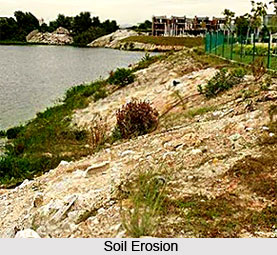Soil Erosion in North and Central Zones is an outcome of the kind of precipitation conditions found existing in these regions. The forests which are encountered in this zone, broadly speaking, are dry and moist deciduous. Weighted average annual rainfall varies from 1080 mm to 1290 mm. Almost half of the year is physiologically dry. Soil erosion problems closely relate with these precipitation conditions. Forests suffer from sheet erosion. In some parts ravines eat out the table top land. Twelve districts of Uttar Pradesh are affected by ravines. Eleven districts of Madhya Pradesh also suffer from ravines.
 Recurrent floods are another important biodegrading factor leading to soil erosion in the North and Central parts of the country. Catchments of eight rivers have been identified as flood prone. All of them lie in the Indo-Gangetic basin. These are Ajoy, Gomti River, Punpun, Roopnarain, Sahibi, Sone, Upper Ganga and Upper Yamuna. The major part of their catchments f alls in the central and northern zone. The states affected by these factors are Bihar, Madhya Pradesh, Uttar Pradesh and West Bengal.
Recurrent floods are another important biodegrading factor leading to soil erosion in the North and Central parts of the country. Catchments of eight rivers have been identified as flood prone. All of them lie in the Indo-Gangetic basin. These are Ajoy, Gomti River, Punpun, Roopnarain, Sahibi, Sone, Upper Ganga and Upper Yamuna. The major part of their catchments f alls in the central and northern zone. The states affected by these factors are Bihar, Madhya Pradesh, Uttar Pradesh and West Bengal.
Another problem is stream bank erosion. There are certain tracts which suffer from salinity and alkalinity. As a result, they have serious impediments in productivity. The shortage of fuel and fodder puts a serious strain on forest resources. Large scale fuel wood collection poses a threat to forests.
The major part of West Bengal, Bihar, Orissa and Eastern Madhya Pradesh including Chhota Nagpur and Chhatishgarh areas contain red soils. Here, sheet erosion is found to exist. It is often followed by gully erosion. Water shortage in these areas is acute. Droughts recur and forests have stunted growth. Pressure from grazing is very severe. Water Table levels are also very low. Ground water recharge is very poor. Black soil regions of Maharashtra and Western Madhya Pradesh suffer from sheet erosion, acute water shortage, recurring droughts and ill drained soils.
Thus given above is a brief glimpse into issue of soil erosion in the Northern and Central areas of the country along with their causative factors.
This article is a stub. You can enrich by adding more information to it. Send your Write Up to content@indianetzone.com















